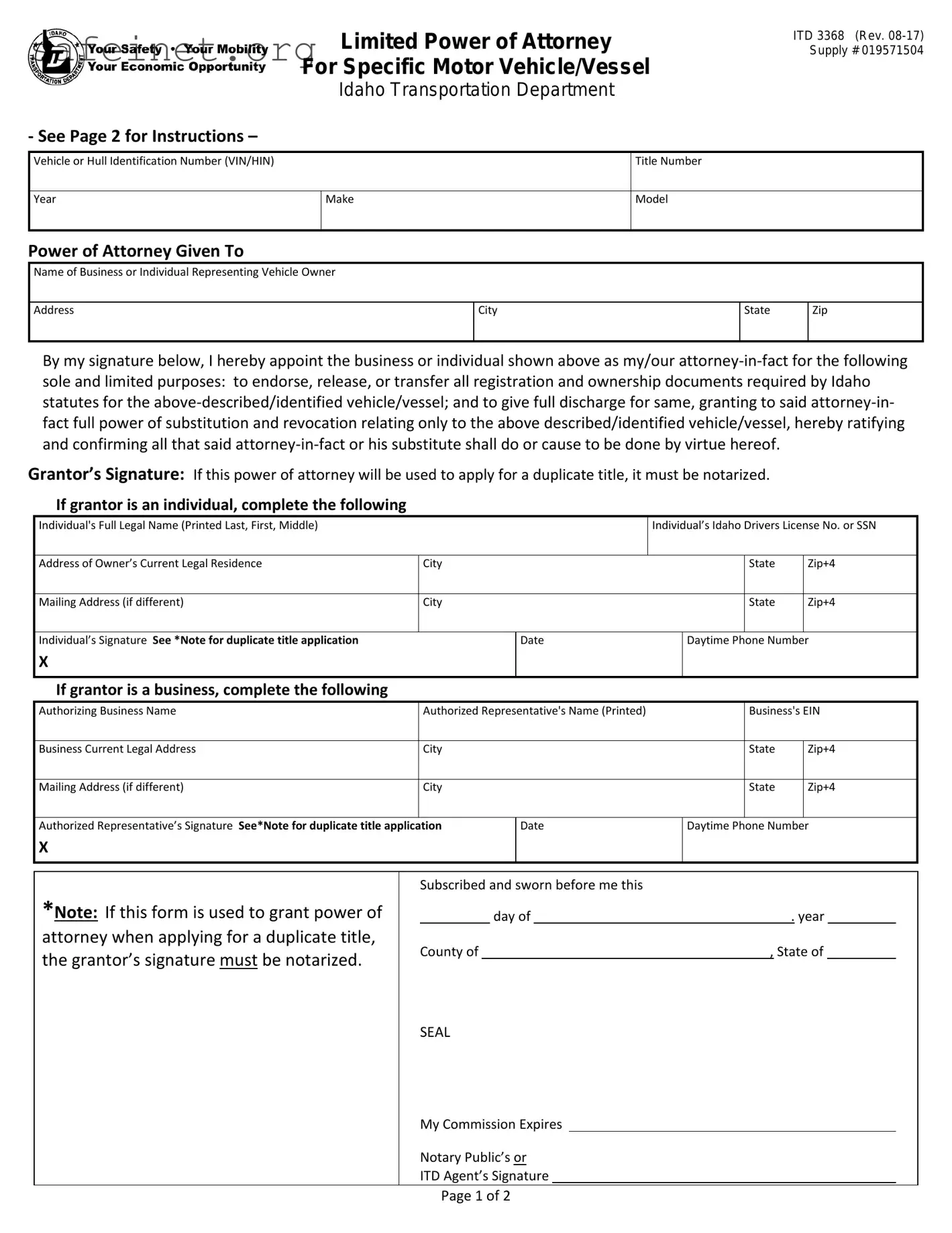
|
|
Limited Power of Attorney |
|
|
ITD 3368 (Rev. 08-17) |
Safety • Your Mobility |
|
|
|
|
Supply # 019571504 |
Your Economic Opportunity |
For Specific Motor Vehicle/Vessel |
|
|
|
|
|
|
|
|
|
|
|
Idaho Transportation Department |
|
|
|
|
- See Page 2 for Instructions – |
|
|
|
|
|
|
|
|
|
|
|
|
|
|
|
Vehicle or Hull Identification Number (VIN/HIN) |
|
|
|
Title Number |
|
|
|
|
|
|
|
|
|
|
Year |
|
Make |
Model |
|
|
|
|
|
|
|
|
|
|
Power of Attorney Given To |
|
|
|
|
|
|
|
Name of Business or Individual Representing Vehicle Owner |
|
|
|
|
|
|
|
|
|
|
|
|
Address |
|
|
City |
|
State |
|
Zip |
|
|
|
|
|
|
|
|
By my signature below, I hereby appoint the business or individual shown above as my/our attorney-in-fact for the following sole and limited purposes: to endorse, release, or transfer all registration and ownership documents required by Idaho statutes for the above-described/identified vehicle/vessel; and to give full discharge for same, granting to said attorney-in- fact full power of substitution and revocation relating only to the above described/identified vehicle/vessel, hereby ratifying and confirming all that said attorney-in-fact or his substitute shall do or cause to be done by virtue hereof.
Grantor’s Signature: If this power of attorney will be used to apply for a duplicate title, it must be notarized.
If grantor is an individual, complete the following
Individual's Full Legal Name (Printed Last, First, Middle) |
Individual’s Idaho Drivers License No. or SSN |
|
|
|
|
|
|
|
|
|
I |
|
|
|
|
Address of Owner’s Current Legal Residence |
City |
|
|
|
|
|
|
|
State |
|
Zip+4 |
|
|
|
|
|
|
|
|
|
|
|
|
|
|
|
|
|
Mailing Address (if different) |
City |
|
|
|
|
|
|
|
State |
|
Zip+4 |
|
|
|
|
|
|
|
|
|
|
|
|
|
|
|
|
|
Individual’s Signature See *Note for duplicate title application |
|
|
|
Date |
|
Daytime Phone Number |
X |
|
|
|
|
|
|
|
|
|
|
|
|
|
|
|
|
|
|
|
|
|
|
|
|
|
|
|
|
|
|
|
|
If grantor is a business, complete the following |
|
|
|
|
|
|
|
|
|
|
|
|
|
|
|
Authorizing Business Name |
Authorized Representative's Name (Printed) |
|
|
Business's EIN |
|
|
|
|
|
|
|
|
|
|
|
|
|
|
|
|
|
Business Current Legal Address |
City |
|
|
|
|
|
|
|
State |
|
Zip+4 |
|
|
|
|
|
|
|
|
|
|
|
|
|
|
|
|
|
Mailing Address (if different) |
City |
|
|
|
|
|
|
|
State |
|
Zip+4 |
|
|
|
|
|
|
|
|
|
|
|
|
|
|
|
|
|
Authorized Representative’s Signature See*Note for duplicate title application |
|
Date |
|
Daytime Phone Number |
X |
|
|
|
|
|
|
|
|
|
|
|
|
|
|
|
|
|
|
|
|
|
|
|
|
|
|
|
|
|
|
|
|
|
|
|
|
|
|
|
|
|
|
*Note: If this form is used to grant power of |
|
Subscribed and sworn before me this |
|
|
|
|
|
|
|
|
|
|
|
day of |
|
|
|
|
|
. year |
attorney when applying for a duplicate title, |
|
|
|
|
|
|
|
|
|
|
|
|
|
|
|
|
|
County of |
|
|
|
|
|
|
|
|
, State of |
the grantor’s signature must be notarized. |
|
|
|
|
|
|
|
|
|
SEAL |
|
|
|
|
|
|
|
|
|
|
|
|
|
|
|
|
|
|
|
|
|
|
|
|
|
|
|
|
|
|
|
My Commission Expires |
|
|
|
|
|
|
|
|
|
|
|
Notary Public’s or |
|
|
|
|
|
|
|
|
|
|
ITD Agent’s Signature |
|
|
|
|
|
|
|
|
|
|
|
|
|
|
|
|
|
|
|
|
|
|
|
|
|
Instructions for Using This Limited Power of Attorney on
Vehicle Title and/or Registration Documents
This limited power of attorney may only be used by the person or firm named as representative on this form. To properly exercise the power of attorney, write the name of the owner followed by the representative’s signature.
Example: |
Sharon Smith by |
Jane Doe, POA |
|
Sharon Smith is the owner and Jane Doe is the person named as representative on the power of attorney.
If the named representative is a company, an authorized individual of that company must sign the document.
Example: Sharon Smith by |
Morrison’s Garage |
|
George Morrison, POA |
Note: The power of attorney must be exercised on the title or document for which the authority was granted. This Power of Attorney must be notarized if given for application of a duplicate title.
Page 2 of 2

